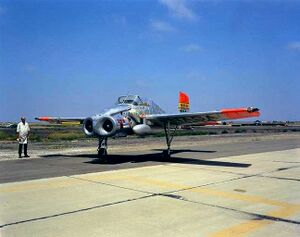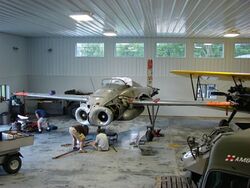Engineering:Bell X-14
| X-14 | |
|---|---|

| |
| Bell Type 68 VTOL | |
| Role | Experimental VTOL |
| Manufacturer | Bell Aircraft |
| First flight | 19 February 1957 |
| Retired | 29 May 1981 |
| Status | Museum Display |
| Primary users | NASA United States Air Force |
| Produced | 1 |
| Number built | 1 |
The Bell X-14 (Bell Type 68) is an experimental VTOL aircraft flown in the United States in the 1950s. The main objective of the project was to demonstrate vectored thrust horizontal and vertical takeoff, hover, transition to forward flight, and vertical landing.
Design and development
| Bell X-14 thrust vectoring vanes | |
Bell constructed the X-14 as an open-cockpit, all-metal (duralumin) monoplane for the USAF. It was powered by two Armstrong Siddeley Viper turbojet engines equipped with thrust deflectors sited at the aircraft's centre of gravity. The engines are fixed in position; transition from vertical to horizontal flight is achieved with a system of movable vanes that control the direction of engine thrust.[1][2] Top speed was 180 miles per hour (290 km/h) with a service ceiling of 20,000 feet (6,100 m). The X-14 was designed using existing parts from two Beechcraft aircraft: wings, ailerons, and landing gear of a Beech Bonanza and the tailcone and empennage of a Beech T-34 Mentor.[3]
Operational history
The X-14 first flew on 19 February 1957 as a vertical takeoff, hover, then vertical landing. The first transition from hover to horizontal flight occurred on 24 May 1958. In 1959, its Viper engines were replaced with General Electric J85 engines. That year the aircraft was delivered to the NASA Ames Research Center as the X-14A. During the development of the P.1127, Hawker test pilots Bill Bedford and Hugh Merewether visited NASA Ames to fly the X-14 and acquaint themselves with jet V/STOL aircraft handling prior to the first flights of the prototype P.1127.[3] It served as a test aircraft with NASA until 1981.
The X-14 project provided a great deal of data on VTOL (Vertical TakeOff and Landing) type aircraft and flight control systems.
In 1971, the X-14A was fitted with new engines (General Electric J85-GE-19) and redesignated the X-14B.[4]<ref= Flying/> An onboard computer and digital fly-by-wire control system were also installed to enable emulation of landing characteristics of other VTOL aircraft.[citation needed]
The aircraft was obtained by NASA and repurposed as a Moon-landing simulator.[5] Neil Armstrong flew the aircraft on numerous occasions, running out of fuel more than once.[6]
The X-14B was used in this test role until it was damaged beyond repair in a landing accident on 29 May 1981.[5] At the time, there were plans to develop an X-14C with an enclosed cockpit. There were also plans for an X-14T trainer. None of these further versions got beyond the planning stage.
During all of its years of service, the X-14 was flown by numerous pilots with no serious incidents or injuries.[6][5]
Aircraft serial numbers
Although there was only one airframe, it changed serial numbers with every major upgrade.
- X-14 - USAF 56-4022[4]
- X-14A - NASA 234 (N234NA)[5]
- X-14B - NASA 704 (N704NA)[citation needed]
Surviving aircraft

The X-14B was rescued from the scrap yard in 1991 and is undergoing renovation as part of the Ropkey Armor and Aviation Museum.[7][8][yes|permanent dead link|dead link}}]</ref>[needs update]
Specifications (X-14B)
Data from Bell aircraft since 1935[9]
General characteristics
- Crew: 1
- Length: 26 ft 0 in (7.92 m)
- Wingspan: 33 ft 9.5 in (10.300 m)
- Wing area: 179.52 sq ft (16.678 m2)
- Airfoil: root: NACA 23016.5; tip: NACA 23012[10]
- Empty weight: 3,173 lb (1,439 kg)
- Gross weight: 4,269 lb (1,936 kg)
- Powerplant: 2 × General Electric J85-GE-19 turbojet engines, 3,015 lbf (13.41 kN) thrust each
Performance
- Maximum speed: 172 mph (277 km/h, 149 kn)
- Range: 300 mi (480 km, 260 nmi)
- Service ceiling: 18,000 ft (5,500 m)
- Thrust/weight: 1.4
Avionics
Auto-stabilisation and computer-controlled engine controls.
See also
Aircraft of comparable role, configuration and era
Related lists
References
- ↑ US patent 2879014, Smith, Stanley W.; Sperazz, Charles M. (Sr.), "Jet Propelled Airplane With Jet Diverter", issued 1959-03-24
- ↑ "Picture of Bell X-14 moveable vanes for thrust vectoring". web site, ropkeyarmormuseum.com. Ropkey Armor Museum. http://www.ropkeyarmormuseum.com/gallery/X14Return2012/RAMX14BReturn02.jpg.[yes|permanent dead link|dead link}}]
- ↑ 3.0 3.1 "Chapter 8, Boundary Layer Control, STOL, V/STOL Aircraft Research". (SP-3300) Flight Research at Ames, 1940-1997, Fifty-Seven Years of Development and Validation of Aeronautical Technology. NASA. 1998. pp. 55–59. https://history.nasa.gov/SP-3300/ch8.htm.
- ↑ 4.0 4.1 Craig Bowman (January 12, 2023). "Bell’s X-14 VTOL Prototype Aircraft That Actually Worked". https://www.jetsprops.com/prototype/bells-vtol-aircraft-that-came-handy-for-lunar-missions-practice.html.
- ↑ 5.0 5.1 5.2 5.3 "Bell Model 68 X-141957". Virtual Aircraft Museum. June 25, 2009. https://www.aviastar.org/air/usa/bell_x-14.php.
- ↑ 6.0 6.1 Jason McDowell (March 21, 2023). "How NASA’s Unconventional Bell X-14 Almost Landed in the Scrapyard". Flying. https://www.flyingmag.com/how-nasas-unconventional-bell-x-14-almost-landed-in-the-scrapyard/.
- ↑ Lowther, Scott. "Bell X-14." up-ship.com. Retrieved: 3 May 2012.
- ↑ "Bell X-14B". Ropkey Armor Museum. 2012. http://www.ropkeyarmormuseum.com/.
- ↑ Pelletier, Alain J. (1992). Bell aircraft since 1935 (1st ed.). London: Putnam Aeronautical. pp. 119–121. ISBN 1557500568.
- ↑ Lednicer, David. "The Incomplete Guide to Airfoil Usage". https://m-selig.ae.illinois.edu/ads/aircraft.html.
Further reading
- Bridgman, Leonard, ed (1958). Jane's All the World's Aircraft 1958-59. London: Jane's All the World's Aircraft Publishing Co. Ltd.. pp. 258–259.
- Markman, Steve; Holder, William G. (2000). Straight up : a history of vertical flight. Atglen: Schiffer Pub. ISBN 0-7643-1204-9.
External links
- Bell X-14 -- NASA X-Plane VTOL - Early test hover and test flight. 2013. Retrieved January 10, 2024.
- Bell X-14 (Bell Type 68). San Diego Air and Space Museum archives. October 4, 2019. Retrieved January 10, 2024.
 |

